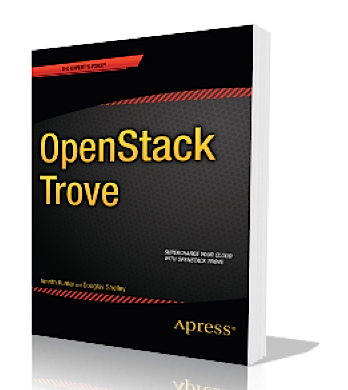If you’re ready to take a deep dive into Trove, OpenStack’s database-as-a-service, things just got a little easier.
Two Active Technical Contributors (ATCs) to the project are here to help with the first book dedicated to it, titled "OpenStack Trove." The book aims to help you wade through downloading and installing Trove as well as plumbing the depths with APIs and orchestrations.
Launched ahead of Trove Day – a free mid-cycle marathon hosted in San Jose, California by Tesora — the 313-page paperback is available online or at Trove Day, with some proceeds to benefit Women Who Code.
Superuser talked to Amrith Kumar and Douglas Shelley, who both work at Tesora, about why you should put this book on your shelf, how to become an OpenStack contributor and why getting women into coding is important to them.

Who will this book help most?
Kumar: The book provides a description of database-as-a-service, describes how to install and use Trove, a very detailed architectural description of Trove and then an in-depth discussion of Trove’s important features.
The book will be very useful for people who want to get started with Trove and get it running quickly. Later, the same people will be able to use the book to not only understand many of the nuances of how Trove works but also how to use some of the more advanced features and troubleshoot problems with Trove.
What’s the one thing most people don’t get about Trove at first?
Shelley: Most people think Trove is about provisioning databases and assume that Trove is nothing more than automation around provisioning. This is not the case at all; Trove is about simplifying the management and operation of database servers throughout their lifetime.
Database servers tend to be long lived; they stay around for much longer than other servers in an application stack. They also store vital application data. Therefore managing a database server (or the database running on it) is a much more complex operation than managing the typical application server. When operating a large number of database servers, doing this manually can be a considerable burden, and highly error prone.
What are some of the most common errors/pitfalls?
Kumar: Managing a database is a complex activity and an IT organization is often responsible for hundreds of servers that are interconnected in complex topologies. Configuration skew, and incorrect setup of capabilities like replication or clustering are two common areas where errors are extremely costly.
Taking the guess work out of database management, and dramatically simplifying the provisioning process through common APIs that support most database workflows make Trove an incredible asset to any IT organization.
There are a lot of books about OpenStack – why is this one worth having on the shelf?
Kumar: That’s an easy question — there are no other books on Trove!
Shelley: Trove is also a relatively new project (incubated in Havana, integrated in IceHouse) and is also a more complex project than the others in several ways. This book provides the reader with a lot of information that is not otherwise easily available elsewhere.
Both of you are OpenStack ATCs, what advice do you have for people who want to contribute?
Kumar: I have only two words of advice for people who want to contribute: “Do It.”
There’s no point in “wanting” to contribute, and it isn’t as though it is hard.
Contributions don’t have to be complex code, features or blueprints. Reviews are valuable and useful to the community and they are a great way to get to know the community, the code, and Trove itself. Read the documentation, use the product, contribute bugs, contribute short write-ups that could be used in improving the documentation, and share your own tips and tricks about using Trove with others. There are numerous ways in which one can contribute and the investment and effort are not high. Most people who I’ve met who “want to contribute” believe that it is hard, or that they have to write a lot of code. That is just not true.
Shelley: It is definitely intimidating making one’s first contribution to an open source project, especially if you are new to open source and come from a closed-source background. However, it is easier to get started than I think folks new to OpenStack believe. There is a wealth of information available via openstack.org to help someone get started. The best way to get going is to work through building and testing a project – look for “low-hanging fruit” bugs that are relatively easy to fix and can get you through the entire process quickly. Code review contributions are also very valuable and a great way to contribute and learn the code base at the same time.
Why are some of the proceeds going to Women Who Code?
Shelley: I’ve been working in information technology and software development for over 25 years and software development, in particular, is a pretty male-dominated field. My expectations were that this would improve over time; certainly women are breaking the “glass ceiling” in other professions. It seems like we as software engineers need to focus on helping out in our corner of the world.
I have two teenage daughters and while I don’t know if they want to be technology professionals, I would hate to think they would be discouraged from entering a field that I’ve enjoyed and benefited from…It is my hope that not only the funds from the books sales help the Women Who Code organization but also the focus we are putting on this can shine a light on this diversity challenge.
Kumar: For at least two generations, members of my family have given their lives to working on causes relating to women’s rights, and this contribution to [Women Who Code] is consistent with the values that I was brought up with…
I believe that there are many talented women who are not getting their fair share of opportunities in the workplace and through the work of organizations like Women Who Code, this injustice is being addressed. Read the recent interview with Victoria Martinez De La Cruz where she recounts her journey and how Outreachy changed her life. Victoria is a fellow member of the Trove Core team and is also on the core team of Zaqar.
Cover Photo by Wiredforsound23 // CC BY NC
- OpenStack Homebrew Club: Meet the sausage cloud - July 31, 2019
- Building a virtuous circle with open infrastructure: Inclusive, global, adaptable - July 30, 2019
- Using Istio’s Mixer for network request caching: What’s next - July 22, 2019

)










